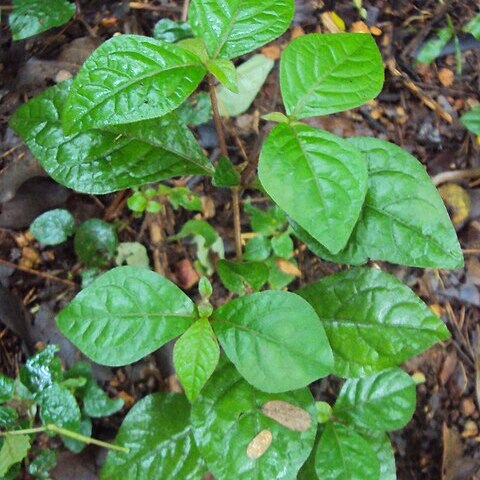Prostrate to erect, annual or perennial herbs, becoming suffruticose near base. Leaves opposite, entire, petiolate, rhombic-ovate. Inflorescence sometimes capitate, usually comprised of long, terminal spikes and subglobose or cylindrical axillary spikes; fertile and sterile flowers clustered in shortly pedunculate glomerules along major axes; glomerules comprised of bracteate triads of 1 central bisexual fertile and 2 modified sterile flowers formed of uncinate, straight or glochidiate spines, all falling together as fruit; bracts ovate, oblong, acuminate; unisexual flowers reduced to tepals with 5 rigid, hooked awns or spines (glochidia), developing in axils of bracteoles after bisexual flowers. Flowers becoming reflexed early in development; tepals 5, free, often hairy; stamens 5, united at base into a tube, anthers 2-locular, oblong, pseudostaminodia 5, fringed, alternating with fertile stamens; ovary obovoid, ovule 1, style filiform, stigma capitate, glandular. Fruit a thin-walled, indehiscent capsule; seed compressed, ellipsoid.
Flowers perfect, some sterile and highly modified, bracteate and bibracteolate, subsessile in short-pedunculate glomerules. Sepals 5, discrete, hypogynous, concave, subequal, 1-3 ribbed, occasionally pungent. Stamens 5, the filaments flattened and united below into an appendiculate tube; anthers 4-locellate, introrse, medially attached. Ovary ovoid, 1-locular, 1-ovulate; ovules campylotropous on elongate flattened funicles; style 1, filiform; stigma 1, capitate. FruLit an ovoid indehiscent utricle; seeds cochleate-orbiculate, succineous. Pubescent branched ascending to prostrate occasionally frutescent herbs. Leaves opposite, entire, petiolate, strigose, deciduous. Inflorescences spicate, composed of terminal and axillary thyrses of complex glomerules containing some highly modified flowers with some of the bracts and sepals uncinate-spinescent.
Perennial herbs or undershrubs. Leaves opposite, entire. Flowers clustered; clusters either singly along the rachis of a long raceme on short, jointed stalks, deflexed after anthesis, or (not in Malaysia) in dense globose heads; perfect flowers in each cluster 1-3, ☿, at least partly accompanied by imperfect sterile ones (reduced to fascicled hooks. Tepals of perfect flowers 5, oblong, shortly acuminate, with scari-ous margins, longitudinally nerved. Stamens 5; filaments at the base connate into a short cup; free parts alternating with shorter, dentate or lacerate pseudo-staminodes; anthers 2-celled (4-locellate). Ovary obovoid; ovule 1, pendulous from a long funicle; style filiform stig-ma capitellate. Utricle ellipsoid, thin-walled, indehiscent, by means of the hooks easily adhering to passers-by.
Herbs, annual or perennial, or subshrubs, covered in fine, semiappressed hairs, most dense in new growth. Leaves opposite, subsessile to petiolate. Inflorescence a spike-like, terminal or axillary raceme, consisting of units of subsessile cymes. Bracts sessile, reflexed, persistent. Flowers bisexual, with the uppermost solitary, the lower in spaced cymes of 1 bisexual flower subtended by two sterile flowers which are reduced to bundles of hooked spines. Bracteoles sessile, deciduous. Tepals 5, free, subequal. Stamens 5; filaments fused at base into short cup; anthers bilocular; staminodes 0; pseudostaminodes 5, alternating with stamens. Ovary: ovule 1; style single; stigma capitate. Fruit an indehiscent utricle, dispersed as a burr of fertile and sterile flowers; immature seed 1, brown, smooth.
Herbs or subshrubs. Stem erect or ascending. Leaves opposite, petiolate, margin entire. Flowers clustered in cymose partial inflorescences, 1-3 in each cluster, hermaphroditic, partly accompanied by sterile ones. Bracts ovate, membranous, often spiny. Tepals 5, nearly equal, membranous. Stamens 5; anther 2-loculed, oblong; filaments connate into a short cup at base, alternating with dentate or lacerate staminodes. Ovary obovoid; ovule 1, pendulous from a long funicle; style filiform, persistent; stigma capitulate. Utricles included in persistent perianth, globose, ellipsoid, or obovoid, membranous, indehiscent. Seeds oblong or ellipsoid.
Inflorescence terminal on the stem and branches, spiciform or capitate, bracteate, the ultimate division basically a triad of fertile flowers, the outer pair bracteolate and subtended laterally by 2 modified bracteolate flowers consisting of a number of sharply uncinately hooked (more rarely straight or glochidiate) spines or bracteoliform processes, but one or both of the outer pair sometimes absent, bracteoles also sometimes with a hooked arista; spines of the modified flowers at first small, rapidly accrescent, few to many, clustered with the clusters not or very shortly stalked.
Perianth segments 5, very shortly mucronate or some (especially the outer 2) hooked-aristate, serving with the bracteoles and modified flowers to distribute the fruit.
Stamens 5, the filaments delicate, shortly monadelphous at the base, alternating with distinct, commonly toothed or lacerate pseudostaminodes; anthers bilocular.
Bracts persistent, finally more or less deflexed; bracteoles and perianth falling with the fruit.
Fruit a thin-walled utricle, irregularly ruptured by the developing seed.
Annual or perennial herbs with entire, opposite leaves.
Seed ovoid, slightly compressed; endosperm copious.
Ovary with a single pendulous ovule.
Style slender, stigma capitate.

